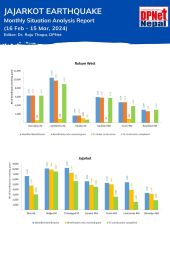Jajarkot Earthquake: Monthly Situation Analysis Report (16 Feb-15 Mar, 2024)
Summary
This situation analysis report highlights the recent developments and challenges faced by the earthquake-affected areas of Jajarkot, Nepal. Nearly four months after the devastating earthquake, the local government declared an emergency in the affected areas, a move prompted by the urgent need for housing reconstruction highlighted by Finance Minister Prakash Sharan Mahat. This declaration enables the Ministry of Finance to request funds from the World Bank, ensuring immediate financial assistance for disaster relief efforts. A significant portion of beneficiaries, approximately 87%, have received grants across municipalities, with shelter construction progress varying significantly across different areas. While some municipalities like Nalgad have shown remarkable efficiency in fund distribution and shelter construction, others lag behind, indicating disparities in administrative efficiency and resource availability.
\Furthermore, the snowfall of February has compounded the difficulties faced by the affected families, many of whom had been living under tarpaulin shelters. The harsh weather conditions have led to a spike in cold-related illnesses, highlighting the urgent need for improved temporary housing solutions. In response, the government has released an additional NPR 900 million for the construction of temporary shelters, aiming to address the immediate needs of the affected population. Local authorities in Rukum West have expressed concerns over delays in constructing permanent structures, urging the federal government to expedite the provision of reconstruction procedures. The importance of transitioning from temporary to permanent housing solutions is emphasized, with local leaders warning of increased hardships if timely action is not taken. The Karnali provincial government has initiated a training program for skilled masons, focusing on constructing earthquake-resistant buildings, a step towards sustainable reconstruction and resilience against future disasters.
The complex interplay between immediate relief efforts like temporary shelter and long-term reconstruction challenges in disaster-affected areas is noteworthy. The variability in fund distribution and shelter construction progress across different municipalities reflects the need for tailored approaches that consider local level capacities and resource availability. As earthquake affected area continues to navigate the aftermath of the Jajarkot earthquake, the collaborative efforts of local, provincial, and federal authorities, along with international support, remain crucial in ensuring the timely and equitable reconstruction of all affected areas.
Categories:
DPNet Publication
Sub-Categories:
Situation Analysis Report
Writer:
Dr. Raju Thapa
Publisher:
DPNet Nepal
Published Year:
2024
